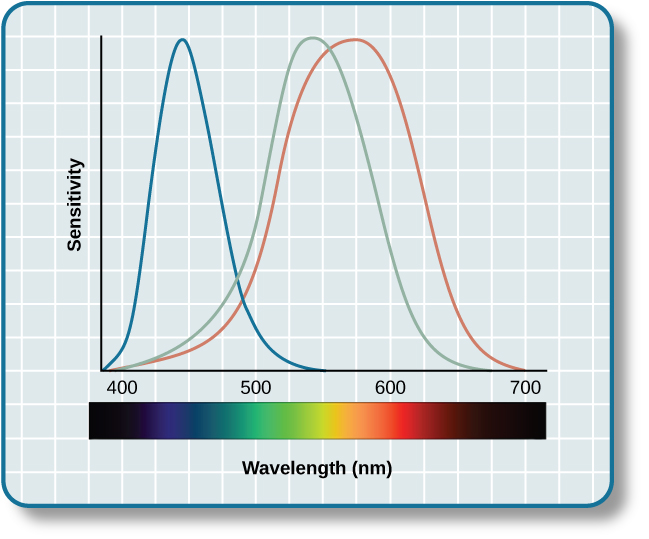| << Chapter < Page | Chapter >> Page > |
We do not see the world in black and white; neither do we see it as two-dimensional (2-D) or flat (just height and width, no depth). Let’s look at how color vision works and how we perceive three dimensions (height, width, and depth).
Normal-sighted individuals have three different types of cones that mediate color vision . Each of these cone types is maximally sensitive to a slightly different wavelength of light. According to the trichromatic theory of color vision , shown in [link] , all colors in the spectrum can be produced by combining red, green, and blue. The three types of cones are each receptive to one of the colors.

The trichromatic theory of color vision is not the only theory—another major theory of color vision is known as the opponent-process theory . According to this theory, color is coded in opponent pairs: black-white, yellow-blue, and green-red. The basic idea is that some cells of the visual system are excited by one of the opponent colors and inhibited by the other. So, a cell that was excited by wavelengths associated with green would be inhibited by wavelengths associated with red, and vice versa. One of the implications of opponent processing is that we do not experience greenish-reds or yellowish-blues as colors. Another implication is that this leads to the experience of negative afterimages. An afterimage describes the continuation of a visual sensation after removal of the stimulus. For example, when you stare briefly at the sun and then look away from it, you may still perceive a spot of light although the stimulus (the sun) has been removed. When color is involved in the stimulus, the color pairings identified in the opponent-process theory lead to a negative afterimage. You can test this concept using the flag in [link] .

But these two theories—the trichromatic theory of color vision and the opponent-process theory—are not mutually exclusive. Research has shown that they just apply to different levels of the nervous system. For visual processing on the retina, trichromatic theory applies: the cones are responsive to three different wavelengths that represent red, blue, and green. But once the signal moves past the retina on its way to the brain, the cells respond in a way consistent with opponent-process theory (Land, 1959; Kaiser, 1997).
Our ability to perceive spatial relationships in three-dimensional (3-D) space is known as depth perception . With depth perception, we can describe things as being in front, behind, above, below, or to the side of other things.
Our world is three-dimensional, so it makes sense that our mental representation of the world has three-dimensional properties. We use a variety of cues in a visual scene to establish our sense of depth. Some of these are binocular cues , which means that they rely on the use of both eyes. One example of a binocular depth cue is binocular disparity , the slightly different view of the world that each of our eyes receives. To experience this slightly different view, do this simple exercise: extend your arm fully and extend one of your fingers and focus on that finger. Now, close your left eye without moving your head, then open your left eye and close your right eye without moving your head. You will notice that your finger seems to shift as you alternate between the two eyes because of the slightly different view each eye has of your finger.
A 3-D movie works on the same principle: the special glasses you wear allow the two slightly different images projected onto the screen to be seen separately by your left and your right eye. As your brain processes these images, you have the illusion that the leaping animal or running person is coming right toward you.
Although we rely on binocular cues to experience depth in our 3-D world, we can also perceive depth in 2-D arrays. Think about all the paintings and photographs you have seen. Generally, you pick up on depth in these images even though the visual stimulus is 2-D. When we do this, we are relying on a number of monocular cues , or cues that require only one eye. If you think you can’t see depth with one eye, note that you don’t bump into things when using only one eye while walking—and, in fact, we have more monocular cues than binocular cues.
An example of a monocular cue would be what is known as linear perspective. Linear perspective refers to the fact that we perceive depth when we see two parallel lines that seem to converge in an image ( [link] ). Some other monocular depth cues are interposition, the partial overlap of objects, and the relative size and closeness of images to the horizon.

Light waves cross the cornea and enter the eye at the pupil. The eye’s lens focuses this light so that the image is focused on a region of the retina known as the fovea. The fovea contains cones that possess high levels of visual acuity and operate best in bright light conditions. Rods are located throughout the retina and operate best under dim light conditions. Visual information leaves the eye via the optic nerve. Information from each visual field is sent to the opposite side of the brain at the optic chiasm. Visual information then moves through a number of brain sites before reaching the occipital lobe, where it is processed.
Two theories explain color perception. The trichromatic theory asserts that three distinct cone groups are tuned to slightly different wavelengths of light, and it is the combination of activity across these cone types that results in our perception of all the colors we see. The opponent-process theory of color vision asserts that color is processed in opponent pairs and accounts for the interesting phenomenon of a negative afterimage. We perceive depth through a combination of monocular and binocular depth cues.

Notification Switch
Would you like to follow the 'Chapter 5: sensation and perception sw' conversation and receive update notifications?